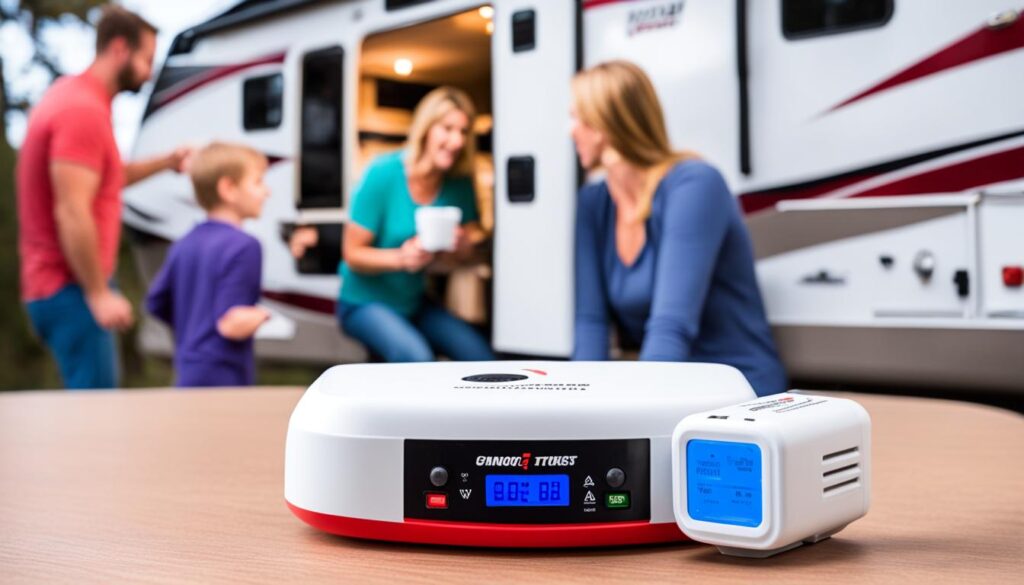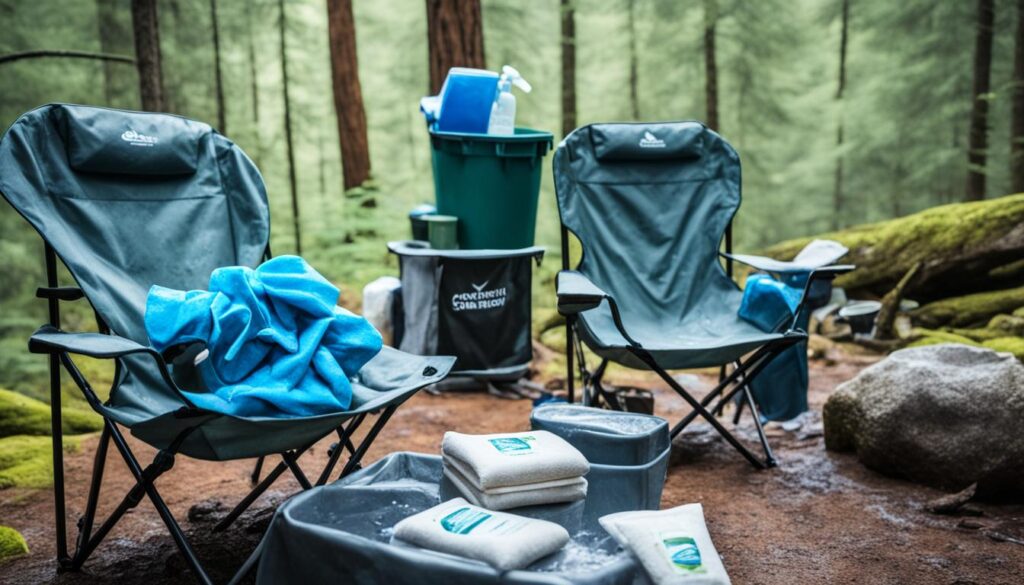Have you ever been woken up in the middle of the night by a loud, piercing beep in your camper? It can be a startling experience, leaving you searching for the source of the noise and wondering if it’s something serious. Well, the answer is yes, it is serious, and it’s time to delve into the world of carbon monoxide detector beeping in RVs.
A carbon monoxide detector is a crucial safety device in any enclosed space, including RVs. When the detector beeps, it is alerting you to potential serious danger. This article will explore the reasons behind carbon monoxide detector beeping in RVs and provide valuable troubleshooting tips to ensure your safety while on the road.
Key Takeaways:
- Carbon monoxide detector beeping in RVs should not be ignored and requires immediate action.
- Understanding the nature of carbon monoxide and the purpose of a carbon monoxide detector is essential for RV owners.
- Different beeping patterns indicate different situations, from dangerous levels of carbon monoxide to low batteries or the end of a detector’s lifespan.
- Regularly testing and maintaining your carbon monoxide detector is crucial for its optimal functioning.
- Choosing the right type of carbon monoxide detector for your RV is important for effective detection and safety.
Contents
What Is Carbon Monoxide and a Carbon Monoxide Detector?
Carbon monoxide (CO) is a silent threat that can be present in your RV without detection. It is an odorless, tasteless, and invisible gas that is produced by gas-powered appliances such as furnaces, water heaters, and generators. Breathing in carbon monoxide can be extremely dangerous and even fatal.
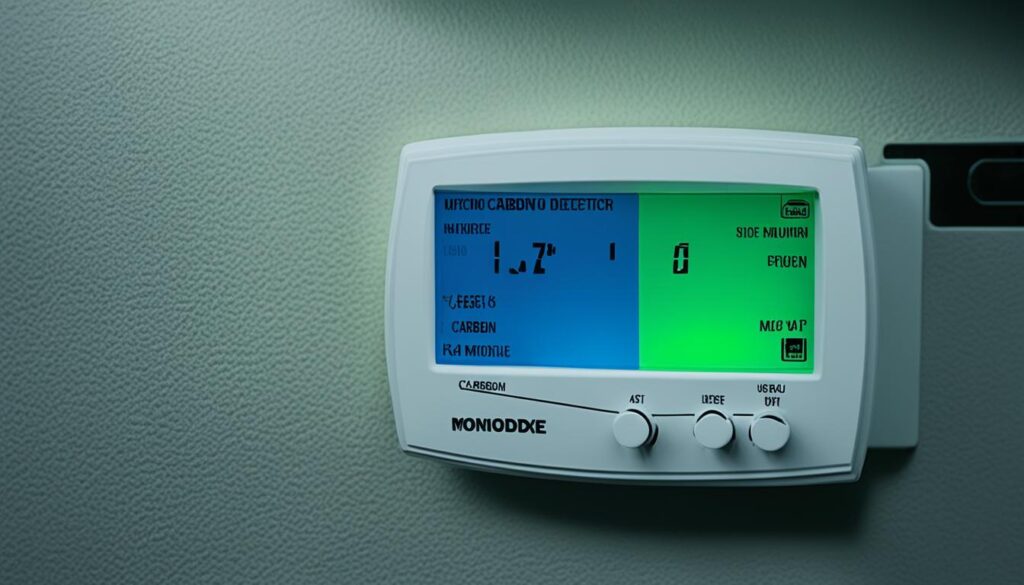
A carbon monoxide detector is a crucial safety device designed to protect you and your loved ones from the dangers of carbon monoxide poisoning. It senses the presence of carbon monoxide in the air and emits a loud alarm to alert you to the danger. By installing a carbon monoxide detector in your RV, you can have peace of mind knowing that you will be warned if there is a potential leak.
Carbon monoxide detectors come in various types and models, but they all serve the same important purpose. They act as an early warning system, giving you time to evacuate the RV and seek help before the gas reaches deadly levels. It is important to note that carbon monoxide detectors should be installed according to the manufacturer’s instructions and regularly tested to ensure proper functioning.
How Does a Carbon Monoxide Detector Work?
A carbon monoxide detector typically consists of a sensor that can detect carbon monoxide levels in the air. When the sensor detects an increased level of carbon monoxide, it triggers an alarm to alert you of the potential danger. The alarm is loud enough to wake you up if you are sleeping and can be heard throughout the RV.
Carbon Monoxide Detector Placement
The placement of carbon monoxide detectors is essential for effective detection. It is recommended to install at least one detector on each level of the RV, including the sleeping areas. The detectors should be mounted at a height of approximately 5 feet from the ground, away from drafts, and at least 15 feet away from fuel-burning appliances.
Carbon Monoxide Detector Maintenance
Regular maintenance of carbon monoxide detectors is crucial to ensure their reliability. It is recommended to test the detector once a month to make sure it is functioning properly. Most detectors have a test button that allows you to easily check if the alarm is working. Additionally, replace the batteries at least once a year or as recommended by the manufacturer.
It’s important to remember that carbon monoxide detectors have a limited lifespan. The sensor in the detector can become less sensitive over time, reducing its effectiveness in detecting carbon monoxide. It is generally recommended to replace the detector every 5 to 7 years, or as indicated by the manufacturer. Some models may have a longer lifespan, so always refer to the manufacturer’s guidelines.
By understanding the nature of carbon monoxide and the purpose of a carbon monoxide detector, you can take the necessary steps to safeguard your RV and protect yourself and your loved ones from this silent threat.
Interpreting Carbon Monoxide Detector Beeping
Carbon monoxide detector beeping can indicate different situations. Understanding the meaning behind the beeping patterns is essential for ensuring your safety while on the road in your RV.
A pattern of 4 beeps followed by a pause is indicative of a dangerous level of carbon monoxide. This requires immediate action, including evacuating the RV and calling for help. Carbon monoxide is a deadly gas, and prolonged exposure can be life-threatening.
If your carbon monoxide detector emits a beeping pattern of 1 beep per minute, it suggests the need to replace the batteries or the detector itself. Regularly checking and replacing batteries is crucial for the optimal functioning of your detector.
On the other hand, a pattern of 5 beeps per minute signals that the carbon monoxide detector has reached the end of its effective life. It is time to replace the detector to ensure continuous and reliable protection against carbon monoxide leaks.
Remember, responding promptly to the beeping patterns of your carbon monoxide detector is vital for your safety and the safety of everyone in your RV. Ignoring or delaying action can lead to serious health risks or even fatalities.
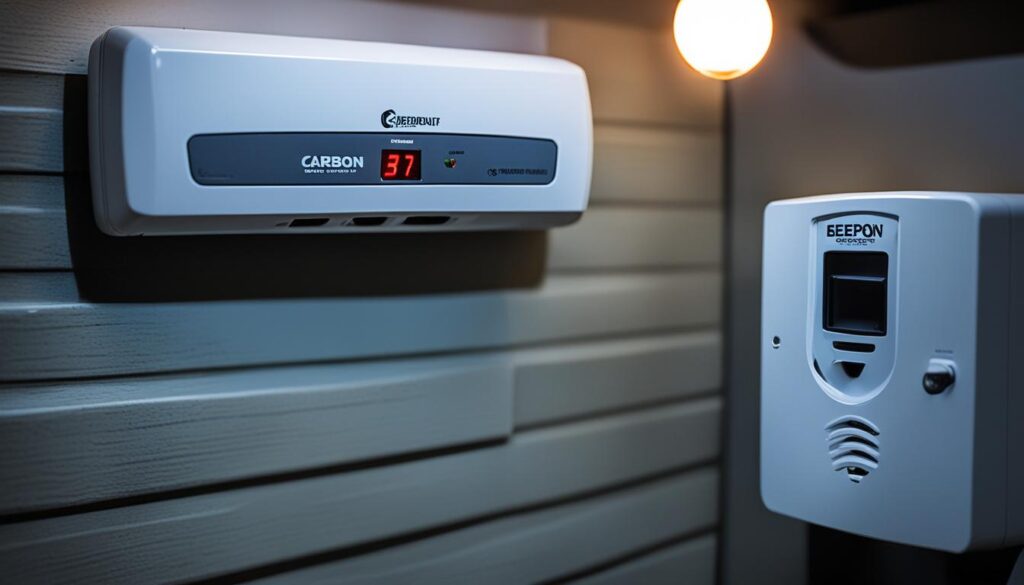
“A pattern of 4 beeps followed by a pause is indicative of a dangerous level of carbon monoxide and requires immediate action.”
– Carbon Monoxide Safety Association
Testing and Maintaining a Carbon Monoxide Detector
Regularly testing and maintaining your carbon monoxide detector is crucial for its optimal functioning. Most detectors have a test button that allows you to ensure it is working properly. It is recommended to test the detector at least once a month.
Testing Your Carbon Monoxide Detector
To test your carbon monoxide detector, simply press the test button and hold it for a few seconds. You should hear a loud, distinct alarm sound. If the alarm does not sound, it may indicate a problem with the detector and further troubleshooting or replacement may be necessary.
Testing is especially important after changing batteries or conducting maintenance on your RV’s gas-powered appliances. It is also a good practice to test the detector before embarking on a trip to ensure its functionality and your safety throughout the journey.
The Lifespan of Carbon Monoxide Detectors in RVs
The lifespan of an RV carbon monoxide detector typically ranges from 5 to 7 years, although some models can last up to 10 years. Over time, the sensors in the detector may become less sensitive, reducing its ability to detect low levels of carbon monoxide.
Replacing your carbon monoxide detector when it reaches its expiration date is essential to ensure reliable protection against carbon monoxide leaks. It is important to consult the manufacturer’s instructions or the detector’s user manual to determine the recommended lifespan and replacement guidelines specific to your model.
By regularly testing and replacing your carbon monoxide detector, you can maintain a safe and secure environment in your RV, protecting yourself and your loved ones from the dangers of carbon monoxide poisoning.
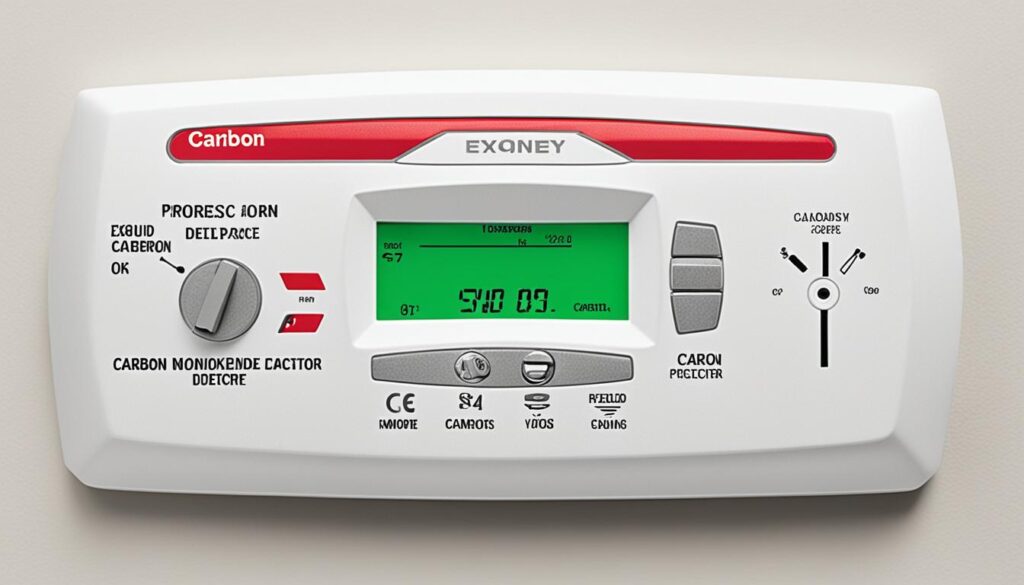
| Carbon Monoxide Detector Model | Lifespan |
|---|---|
| Model A | 5 years |
| Model B | 7 years |
| Model C | 8 years |
| Model D | 10 years |
Buying a New Carbon Monoxide Detector for Your RV
When it comes to the safety of your RV and its occupants, choosing the right carbon monoxide detector is of utmost importance. With the wide array of options available, such as ceiling/wall mount detectors, RV CO & LPG detectors, and combined CO & smoke detectors, it can be overwhelming to make the right choice. To ensure you select the most suitable detector for your RV, consider the following:
1. Identify Your Current Detector
Start by checking the model number of your current carbon monoxide detector. This information will help you determine the exact replacement you need. By choosing a compatible replacement, you can easily install the new detector without any additional modifications or adjustments.
2. Understand Your RV’s Requirements
Consider the specific requirements of your RV when selecting a new carbon monoxide detector. Factors such as the size of your RV, the number of occupants, and the type of appliances and heating systems installed can influence the detector’s effectiveness. Understanding these requirements will ensure you choose a detector that provides reliable protection.
3. Consider Additional Features
While the primary function of a carbon monoxide detector is to alert you to the presence of gas, some models offer additional features that can enhance your RV’s safety. These features may include built-in digital displays, battery backup options, and wireless connectivity to synchronize multiple detectors. Assess your preferences and prioritize the features that align with your needs.
4. Look for Certifications and Standards
Ensure the carbon monoxide detector you select complies with industry certifications and safety standards. Look for detectors that have been tested and approved by recognized organizations, such as UL (Underwriters Laboratories) or CSA (Canadian Standards Association). These certifications indicate that the detector meets stringent safety requirements and has undergone thorough testing.
5. Read Customer Reviews
Before making a final decision, take the time to read customer reviews and ratings of the carbon monoxide detectors you are considering. Real-life experiences can provide valuable insights into the detector’s performance, ease of installation, and overall user satisfaction. Look for detectors that consistently receive positive reviews and have a reputation for reliability.
By following these guidelines and considering your RV’s specific needs, you can confidently purchase a new carbon monoxide detector that will enhance the safety of your RV and provide peace of mind during your travels.
Remember, prioritizing safety is crucial, and investing in a high-quality carbon monoxide detector is a small price to pay for the well-being of yourself and your loved ones on the road.
Ensuring RV Safety with Carbon Monoxide Detectors
The safety of your RV and its occupants should always be a top priority. To maintain a safe RV experience, it is crucial to regularly check and maintain your carbon monoxide detector, along with other essential safety devices like smoke detectors. Proper maintenance of these devices is paramount, as they serve as your first line of defense against potentially life-threatening situations.
Regularly scheduled maintenance of your carbon monoxide detector involves checking its functionality, testing the alarm, and ensuring that the batteries are in good condition. It is recommended to test the detector monthly and replace the batteries at least once a year. Additionally, it is vital to familiarize yourself with the specific maintenance instructions provided by the manufacturer to ensure optimal performance.
In addition to proper carbon monoxide detector maintenance, taking preventive measures can help minimize the risk of carbon monoxide leaks in your RV. Proper ventilation is crucial, especially when using gas-powered appliances. Keep windows and vents open to allow fresh air to circulate and prevent the accumulation of harmful gases. It is also essential to exercise caution when using gas-powered appliances and never leave them unattended.
By prioritizing RV safety and implementing regular carbon monoxide detector maintenance, as well as adopting preventive measures, you can enjoy your travels with peace of mind. Taking these necessary precautions will not only protect you and your loved ones from the dangers of carbon monoxide, but also ensure a safer overall RV experience.
FAQ
Why is my carbon monoxide detector beeping in my RV?
There are several reasons why a carbon monoxide detector may beep in an RV. It could indicate a dangerous level of carbon monoxide, a low battery, or that the detector has reached the end of its effective life.
What should I do if my carbon monoxide detector in my RV is beeping with a pattern of 4 beeps followed by a pause?
A pattern of 4 beeps followed by a pause is indicative of a dangerous level of carbon monoxide. In this situation, it is important to immediately evacuate the RV, call for help, and address the source of the carbon monoxide leak.
My RV carbon monoxide detector is beeping 1 beep per minute. What does this mean?
If your carbon monoxide detector is beeping 1 beep per minute, it suggests the need to replace the batteries or the detector itself. Check the batteries first and if the beeping continues, consider replacing the detector.
What does it mean if my RV carbon monoxide detector is beeping 5 times per minute?
A beeping pattern of 5 beeps per minute indicates that the detector has reached the end of its effective life and needs to be replaced. It is important to replace the detector with a new one to ensure ongoing protection against carbon monoxide.
How often should I test my RV carbon monoxide detector?
It is recommended to test your RV carbon monoxide detector at least once a month to ensure it is working properly and providing accurate readings. Regular testing helps to ensure your safety while on the road.
What is the lifespan of an RV carbon monoxide detector?
The lifespan of an RV carbon monoxide detector typically ranges between 5 and 7 years. However, some models can last up to 10 years. It is important to check the expiration date of your specific detector and replace it accordingly to ensure reliable protection against carbon monoxide.
What type of carbon monoxide detector should I purchase for my RV?
When purchasing a new carbon monoxide detector for your RV, it is important to choose the right type for your specific needs. There are different options available, including ceiling/wall mount detectors, RV CO & LPG detectors, and combined CO & smoke detectors. Consider your RV’s requirements and check the model number of your current detector to make an informed decision.
How can I ensure the safety of my RV and its occupants with carbon monoxide detectors?
Ensuring the safety of your RV and its occupants involves regular maintenance of carbon monoxide detectors and other safety devices like smoke detectors. Regularly check and test your carbon monoxide detector, follow proper ventilation practices, and be cautious with gas-powered appliances to avoid carbon monoxide leaks. Prioritizing RV safety will provide you with peace of mind during your travels.
